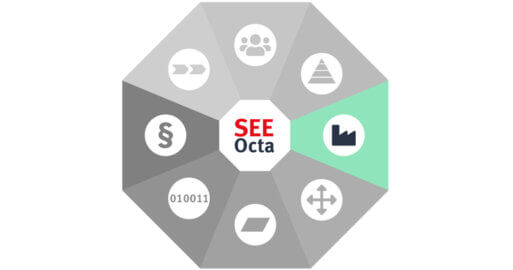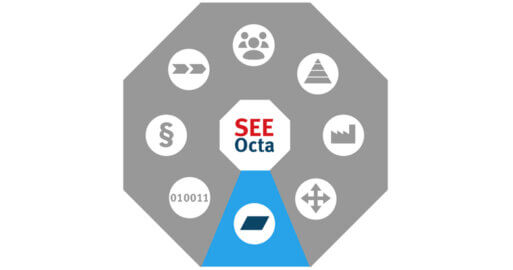SEEOcta – Locations: Working from Home

Working from home, or working remotely are subjects undergoing a serious rethink in the business world. As COVID-19 took over our world last year, huge numbers of employees were suddenly sent home to continue working in their own four walls. One year on, many have now developed a taste for this type of working. That a majority of employees would like to be able to switch more often between being at the office and working from home could already be seen in an ESET study from April 2020, which we referred to in an earlier post on digitalisation and working from home. Some employees would prefer to work completely from home. With the right IT environment and structures, you could enable your employees to work as easily from home as in the office, which would impact positively on your attractiveness as an employer. The focus needs to be on IT security and data protection.
The SEEOcta blog series highlights the eight most important perspectives for successful project management. Discover all the areas you need to consider when planning digitalisation and integration projects in your company. Armed with the ideas and knowledge in the articles, you will have a solid foundation for planning your IT project and a guide to help you ensure that no one gets left behind.
Not so very long ago, for the majority of employees it was unusual to work from home. According to a survey by Bitkom[1], in March 2020 one fifth of employees sent home due to the threat of COVID-19 were working from home for the very first time. Just one month later, ESET discovered in their study that 41% of employees were either working primarily or completely from home, with 68% of these wishing to still have the opportunity to do so once the COVID-19 pandemic had abated.
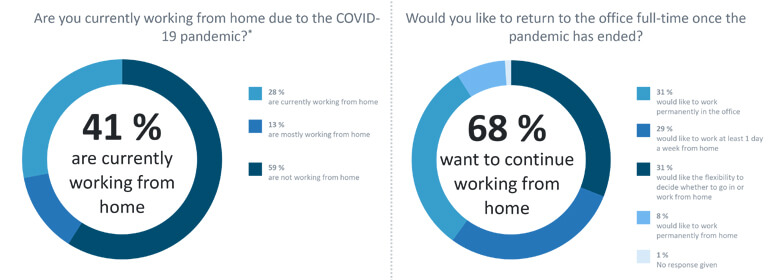
Advantages and disadvantages of working from home
There are a number of advantages for both companies and employees of enabling staff to work remotely. Employees tend to appreciate the time saved by not having to commute, more freedom in how and where they complete their work, and a better ability to juggle family and work commitments. And if an employee benefits, so does their employer. Productivity tends to rise as employees are able to get more done in a work day, often taking fewer breaks or time off.
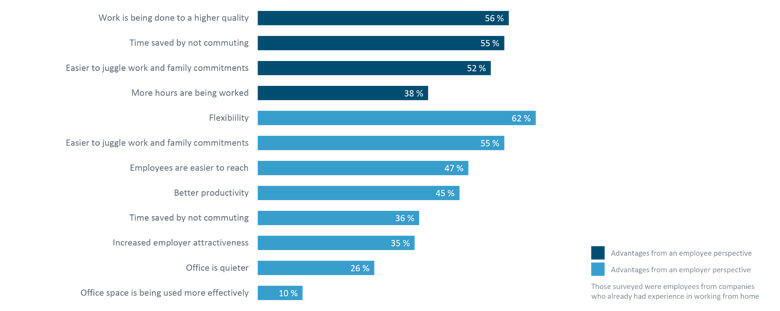
Reasons for not embracing working from home from the point of view of both employer and employee, include tasks which simply cannot be done remotely, a lack of technical resources and data protection issues.
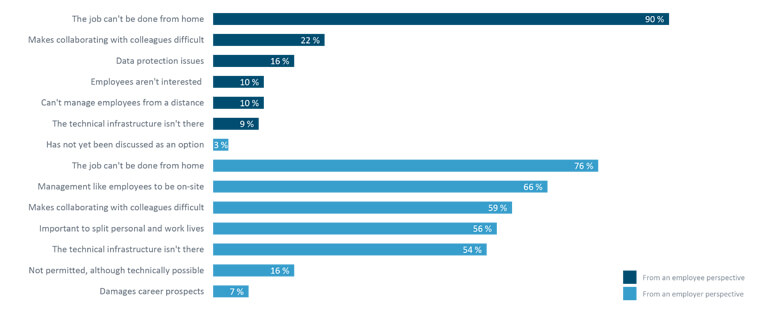
Home is where the Wi-Fi is
In the long term, employers are not going to escape having to offer their staff more flexibility in where they work. For many organisations, the COVID-19 pandemic has been a litmus test of their digitalisation strategy – or lack thereof. Technical resources have needed to be put in place, data protection measures set up and communication channels created. There is also a lot of organisational work in enabling colleagues to work together at a distance. Data protection measures off premises is still an issue causing many employers headaches. Who is responsible, or liable, for what? What does the GDPR say? How should an employee’s new work environment be set up and what rules should an employee adhere to so that confidential information remains so?
As already mentioned, it’s often technology which makes working from home difficult or even impossible. Networks break down, connections are slow and negatively impact reaction and download speed. An employee can also only work as well as his Wi-Fi connection, with issues here not only negatively affecting the quality- or feasibility – of video conferencing with colleagues and clients/suppliers, but also his ability to do anything online.
Secure data transfer from outside the office with Managed File Transfer (MFT)
The first step to ensuring secure, effective access to a corporate network off-premises is to set up a VPN. However, transferring data is often still not particularly secure and is often the weakest link in a system. Security loopholes are exploited by cyber criminals with phishing attacks, in the worst case gaining access to all a company’s data. The risks and consequences of using e-mail or FTP to transfer confidential files should not be underestimated. FTP stands for File Transfer Protocol and is used to transfer large, unstructured files between systems and people. However, it isn’t particularly secure. Managed File Transfer solutions are much better suited to transferring confidential data securely and should be used ahead of other – often improvised – solutions such as public file sharing services or even sticking a flash drive or similar in the post. This infographic from SEEBURGER illustrates the everyday challenges inherent in data transfer.
Securely connect to an internal database via API
In order to be able to do their work, a number of employees still need regular access to corporate data. This may be a database, an accounting or inventory programme, client or supplier details, etc. The systems behind this data often interact with each other via APIs. However, the access to these gateways to sensitive corporate data needs to be well protected. There are a number of measures which can ensure API security, protecting data from external attacks on the backend systems as well as administering and confirming user permissions and authorisation to ensure that only those who are permitted to actually access the data. The cornerstone of this is the API gateway, which check the authorisation and authentication credentials of would-be users and manages traffic.
Secure cloud solutions to enable working from home
As working from home is becoming more prevalent, cloud solutions are experiencing a strong upswing. However, it’s important that any provider you may choose has an extremely high standard of data security. Certification, such as ISO/IEC 27001 shows that a cloud provider has proved its ability to ensure data security at all levels.
Conclusion
Employees are going to increasingly expect to be able to work from home in some form, even when the current COVID-19 pandemic is a distant memory. In order to be able to enable this, employers need to ensure that their IT security is up-to-scratch. The SEEOcta series offers a variety of pointers to achieving this undertaking in a structured, efficient way.
[1] https://www.bitkom.org/Presse/Presseinformation/Corona-Pandemie-Arbeit-im-Homeoffice-nimmt-deutlich-zu
[2] https://www.channelpartner.de/a/unternehmen-werden-heimarbeit-nach-der-coronakrise-nicht-mehr-los,3337664
Thank you for your message
We appreciate your interest in SEEBURGER
Get in contact with us:
Please enter details about your project in the message section so we can direct your inquiry to the right consultant.
Written by: Rolf Holicki
Rolf Holicki, Director BU E-Invoicing, SAP&Web Process, is responsible for the SAP/WEB applications and digitization expert. He has more than 25 years of experience in e-invoicing, SAP, Workflow and business process automation. Rolf Holicki has been with SEEBURGER since 2005.


